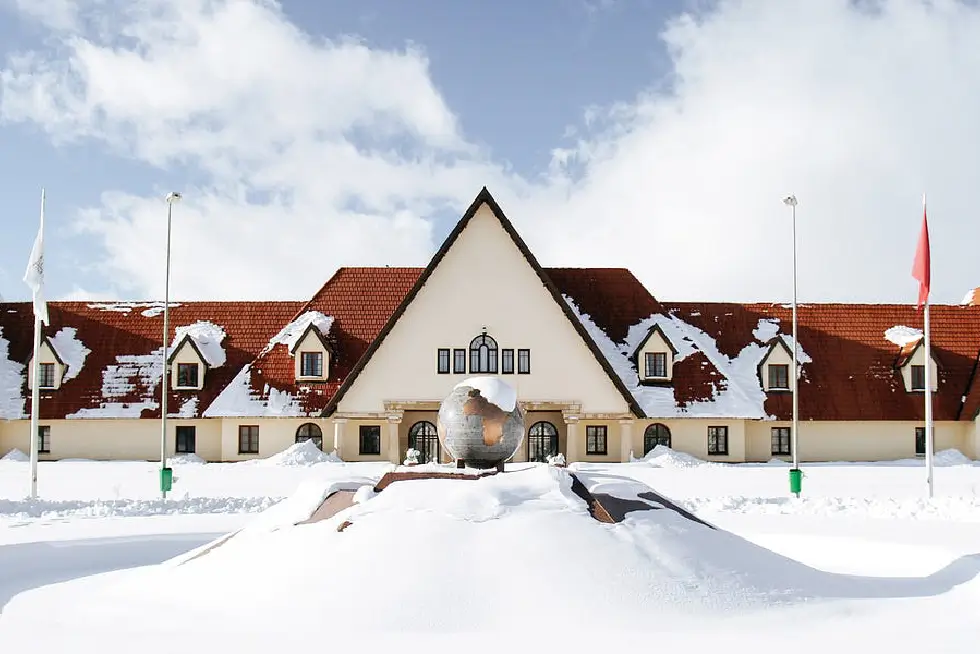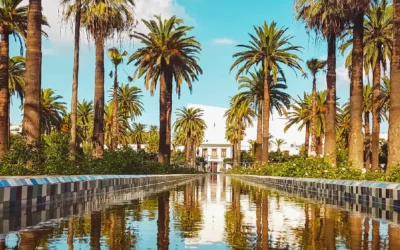Ifrane City / Town: The Switzerland Of Morocco / The Alpine Retreat

Table of Contents:
Introduction to Ifrane City / Town
Ifrane is often referred to as both a city and a town. Dubbed the “Switzerland of Morocco”, is a captivating town Located in the Middle Atlas mountains, in the Fès–Meknès region of Morocco.
At an impressive elevation of about 1,650 meters, this modern town is a celebrated hub for both winter and summer activities. Its claim to fame? The stunning alpine-style architecture, creates an ambiance akin to a European mountain village, like in Switzerland.
Ifrane’s roots stretch back to the 16th century, but its most transformative era came under French colonial rule in the early 20th century.
Here, it was envisioned as a hill station—a serene escape for colonial families from the summer heat. Its architectural identity, inspired by styles like “Maison basque,” “Jura,” and “Savoy,” was deliberately chosen to evoke the essence of Europe.
Ifrane Discovery Tour
Ifrane, often referred to as the “Switzerland of Morocco,” offers a variety of captivating attractions that make it a unique destination. Some of the most popular places to visit in Ifrane include:
1. Ifrane National Park
Spanning a vast 500 square kilometers, this park is a sanctuary for wildlife, including the rare Barbary macaque. Draped in the scent of Atlas cedar trees, it’s a paradise for bird watchers and wildlife enthusiasts.
2. Parc la Prairie
Find peace and tranquility in this serene park. With its forest trails and diverse birdlife, it’s the perfect place for nature lovers to unwind.
3. Town Center of Ifrane
Experience the charm of European-style chalets and stunning mountain views. The town center, with its quaint fountains and gardens, offers a unique and soothing atmosphere.
4. Swiss-Like Architecture
Near the Visitor Centre, the chalet-style buildings whisk you away to a European alpine village. It’s a picturesque area that’s ideal for photography enthusiasts.
5. The Large Lion Sculpture
This famous landmark, believed to honor the last wild Atlas lion, is a popular photo stop for visitors.
6. Al Akhawayn University
Explore the impressive campus of this English-language university, established by King Hassan II. The university is known for its excellent facilities and offers tours to interested visitors.
7. Michlifen Ski Resort
A haven for winter sports lovers, offering skiing, sledding, and snowboarding. With a kilometer of slopes and a ski lift, it provides breathtaking views of the region.
8. Source Vitel
Nestled within Ifrane’s forests, this spot features enchanting waterfalls, making it an ideal picnic location and a chance to witness local natural refrigeration techniques.
9. The Souk in Ifrane
Dive into Moroccan culture at the souk. While it caters more to locals, it’s a great place to observe Moroccan shopping customs and pick up unique handicrafts and souvenirs.
10. Lake Dait Aoua
This expansive lake is a hub for activities, surrounded by stunning mountain scenery. Enjoy pedal boating, horse riding, or a stroll along its peaceful shores.
Ifrane Accessibility And Transportation
Ifrane’s accessibility and transportation options cater to a range of preferences, whether you’re looking for the affordability of public buses, the convenience of taxis, or the adventure of a road trip. Keep in mind the seasonal variations, especially in winter, to plan your travel accordingly.
A. Getting to Ifrane:
1. By Bus:
Embark on a scenic 45-minute journey from Fez to Ifrane with the reliable CTM bus service, operating daily. For those venturing from other cities like Azrou, Beni Mellal, and more, local buses present an economical, albeit less luxurious, choice.
2. By Grand Taxi:
Opt for a quicker, more direct route with grand taxis from Fez or Meknes—approximately an hour’s drive, with possible surges during peak times or weekends.
3. By Car:
Enjoy the freedom and convenience of driving to Ifrane. The direct route from Fez makes for an effortless drive. However, winter travelers should stay updated with weather forecasts to avoid road closures due to snow.
4. By Train:
While direct train services to Ifrane are unavailable, trains to nearby cities like Fez or Meknes can be a starting point. From there, taxis or buses can take you to Ifrane.
B. Getting Around Ifrane:
1. On Foot:
Ifrane’s compact layout makes it ideal for exploring on foot. Wander the streets and soak in the town’s unique blend of Moroccan and European influences.
2. Petit Taxis:
For quick trips within the city, petit taxis are a budget-friendly and convenient choice, perfect for short distances.
Modern Ifrane and its Economic Significance
Modern Ifrane holds significant economic importance due to its unique blend of cultural and natural attractions. Situated in the heart of the Middle Atlas, Ifrane has developed a robust tourist economy.
Tourism and Educational Hub
The city’s economic lifeblood flows from its thriving tourism sector. Renowned for its tranquil resorts and sports facilities, Ifrane attracts a diverse array of visitors seeking both adventure and relaxation in its scenic landscape.
This tourism allure is enhanced by Al Akhawayn University, a prestigious institution offering an English-language curriculum. The university serves as an educational beacon and contributes to the city’s cosmopolitan ambiance.
A Center for Economic Dialogue
Ifrane’s role on the economic stage has been further solidified through events like the African Trade and Investment Forum. These gatherings spotlight Ifrane’s strategic importance in facilitating economic discussions and collaborations within Africa.
Such events underscore Ifrane’s growing influence in regional socio-economic development, showcasing its potential as a crossroads for international dialogue and business exchange.
Ifrane History Overview
1. The Origins of Ifrane
Tracing back to the 16th century, Ifrane’s origins are as captivating as its picturesque landscape. Founded by Sharif Sîdî ‘Abd al-Salâm in the Tizguit Valley, the earliest community, known as Zaouiat Sidi Abdeslam, was uniquely situated in cave dwellings. Fascinatingly, ‘Ifran’ means “caves” in the local Amazigh language.
Over centuries, this enclave flourished, bolstered by a grant from Sultan Mûlây Rashîd b. Muhammad in the mid-17th century. The area thrived on agriculture, livestock grazing, and forest resources, laying the groundwork for future growth.
2. The Birth of Modern Ifrane
1929 marked a pivotal year for Ifrane, with the French establishing the town as we know it during their Moroccan protectorate era. Envisioned as a “hill station,” it provided a serene escape for colonial families from the sweltering summer heat.
The town’s layout mirrored the “garden city” concept prevalent in Western Europe, adorned with Alpine-style chalet summer homes, lush gardens, and winding tree-lined streets.
A royal palace for Sultan Muhammad b. Yûsuf and essential public buildings like a post office and a church were also constructed, setting the stage for Ifrane’s unique architectural blend.
3. Post-Independence Evolution
Following Morocco’s independence, Ifrane underwent a substantial transformation. French colonial transitioned to Moroccan ownership, and the town expanded with new facilities like a mosque and a market.
In 1979, its elevation to the administrative center of its province catalyzed further development. The 1995 establishment of Al Akhawayn University, an English-speaking institution with an American curriculum, signified a new chapter in Ifrane’s history, enhancing its status as a sought-after tourist destination.
Conclusion
Ifrane is not just a city / town but a narrative of transformation and endurance. It embodies the essence of Morocco’s journey, weaving together threads of history, culture, and modernity into a tapestry that is as beautiful as it is inspiring.
This makes Ifrane not just a place to visit, but a destination to experience, remember, and cherish.
FAQ
Why is Ifrane known as the ‘Switzerland of Morocco’?
Ifrane is dubbed the ‘Switzerland of Morocco’ due to its stunning alpine-style architecture and its location in the Middle Atlas mountains, creating an ambiance similar to a European mountain village.
What is the elevation of Ifrane?
Ifrane is located at an impressive elevation of about 1,650 meters.
What are some popular attractions in Ifrane?
Key attractions include Ifrane National Park, Parc la Prairie, the town center with European-style chalets, Swiss-like architecture near the Visitor Centre, the Large Lion Sculpture, Al Akhawayn University, Michlifen Ski Resort, Source Vitel, the local Souk, and Lake Dait Aoua.
How can I get to Ifrane?
You can reach Ifrane by bus (like the CTM service from Fez), grand taxis from Fez or Meknes, by car, or by train to nearby cities followed by a bus or taxi to Ifrane.
What are the transportation options within Ifrane?
In Ifrane, you can explore on foot due to its compact layout or use petit taxis for quick trips within the city.
What makes Ifrane economically significant?
Ifrane’s economy is driven by its tourism sector, thanks to its tranquil resorts and sports facilities, and the presence of Al Akhawayn University. It also plays a role in regional socio-economic development and international dialogue.
What is the history of Ifrane?
Ifrane’s history dates back to the 16th century. The modern town was established in 1929 under French colonial rule as a hill station. Post-independence, it underwent significant transformations and further developed with the establishment of Al Akhawayn University in 1995.



